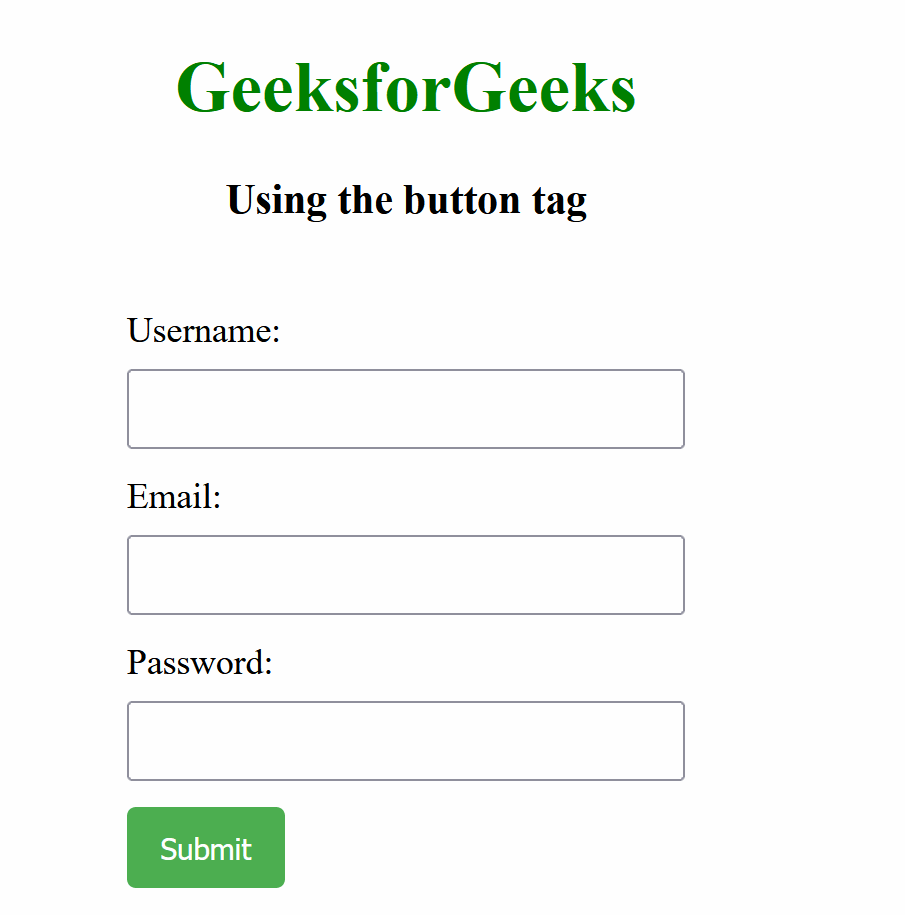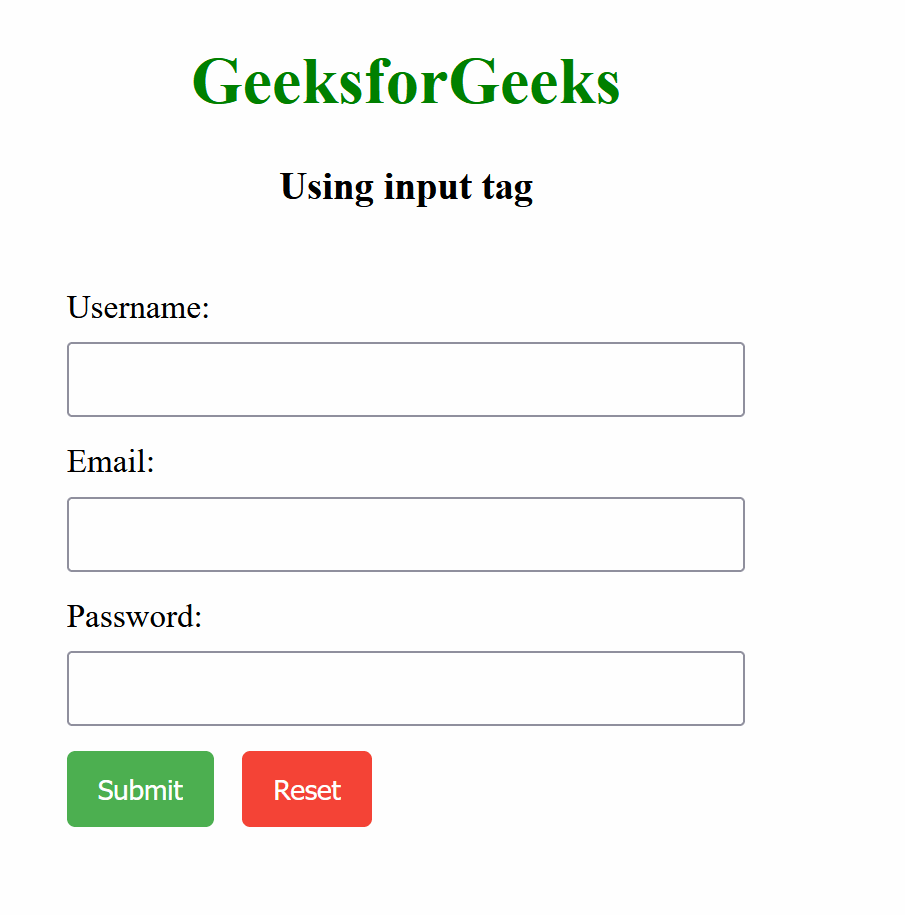How to Create Form Submit Button in HTML ?
Last Updated :
18 Mar, 2024
In HTML, the form submit button is an important element in sending the user’s data to the server for further processing. We can create these buttons using two different approaches like <input> or <button> tag.
In this approach, we are using the <button> tag to create a submit button within an HTML form. The button is styled with CSS for green background color, white text, and a hover effect, and its functionality is defined through a JavaScript event listener to display an alert when clicked.
Syntax:
<button type="button" id="submitButton">Submit</button>
Example: The below example uses <button> tag to create a Form Submit button in HTML.
HTML
<!DOCTYPE html>
<html>
<head>
<title>Example 1</title>
<link rel="stylesheet" href="style.css">
</head>
<body>
<h1>GeeksforGeeks</h1>
<h3>Using the button tag</h3>
<form>
<label for="username">Username:</label>
<input type="text" id="username"
name="username" required>
<label for="email">Email:</label>
<input type="email" id="email"
name="email" required>
<label for="password">Password:</label>
<input type="password" id="password"
name="password" required>
<button type="button"
id="submitButton">
Submit
</button>
</form>
<script>
document.addEventListener(
'DOMContentLoaded', () => {
document.getElementById('submitButton').
addEventListener('click', function () {
alert('Form submitted!');
});
});
</script>
</body>
</html>
h1 {
color: green;
text-align: center;
}
body {
text-align: center;
}
form {
display: inline-block;
text-align: left;
max-width: 400px;
margin: 20px auto;
}
label {
display: block;
margin-bottom: 8px;
}
input {
width: 100%;
padding: 8px;
margin-bottom: 12px;
box-sizing: border-box;
}
button {
background-color: #4caf50;
color: white;
padding: 10px 15px;
border: none;
border-radius: 4px;
cursor: pointer;
}
button:hover {
background-color: #45a049;
}
Output:

In this approach, we are using the <input> tag to create form fields and buttons within an HTML form. The styling is applied through CSS, between the submit button with a green background and the reset button with a red background. JavaScript is used to add functionality, which triggers alerts when the submit or reset buttons are clicked.
Syntax:
<input type="submit" class="submitButton" id="submitButton" value="Submit">
Example: The below example uses <input> tag to create a Form Submit button in HTML.
HTML
<!DOCTYPE html>
<html>
<head>
<title>Example 2</title>
<link rel="stylesheet" href="style.css">
</head>
<body>
<h1>GeeksforGeeks</h1>
<h3>Using input tag</h3>
<form>
<label for="username">Username:</label>
<input type="text" id="username"
name="username" required>
<label for="email">Email:</label>
<input type="email" id="email"
name="email" required>
<label for="password">Password:</label>
<input type="password" id="password"
name="password" required>
<input type="submit" class="submitButton"
id="submitButton" value="Submit">
<input type="reset" class="resetButton"
id="resetButton" value="Reset">
</form>
<script>
document.addEventListener(
'DOMContentLoaded', function () {
document.getElementById('submitButton').
addEventListener('click', function () {
alert('Submit button clicked!');
});
document.getElementById('resetButton').
addEventListener('click', function () {
alert('Reset button clicked!');
});
});
</script>
</body>
</html>
h1 {
color: green;
text-align: center;
}
body {
text-align: center;
}
form {
display: inline-block;
text-align: left;
max-width: 400px;
margin: 20px auto;
}
label {
display: block;
margin-bottom: 8px;
}
input[type="text"],
input[type="email"],
input[type="password"] {
width: 100%;
padding: 8px;
margin-bottom: 12px;
box-sizing: border-box;
}
.submitButton {
background-color: #4caf50;
color: white;
padding: 10px 15px;
border: none;
border-radius: 4px;
cursor: pointer;
margin-right: 10px;
}
.resetButton {
background-color: #f44336;
color: white;
padding: 10px 15px;
border: none;
border-radius: 4px;
cursor: pointer;
}
button:hover,
.resetButton:hover {
opacity: 0.8;
}
Output:

Share your thoughts in the comments
Please Login to comment...